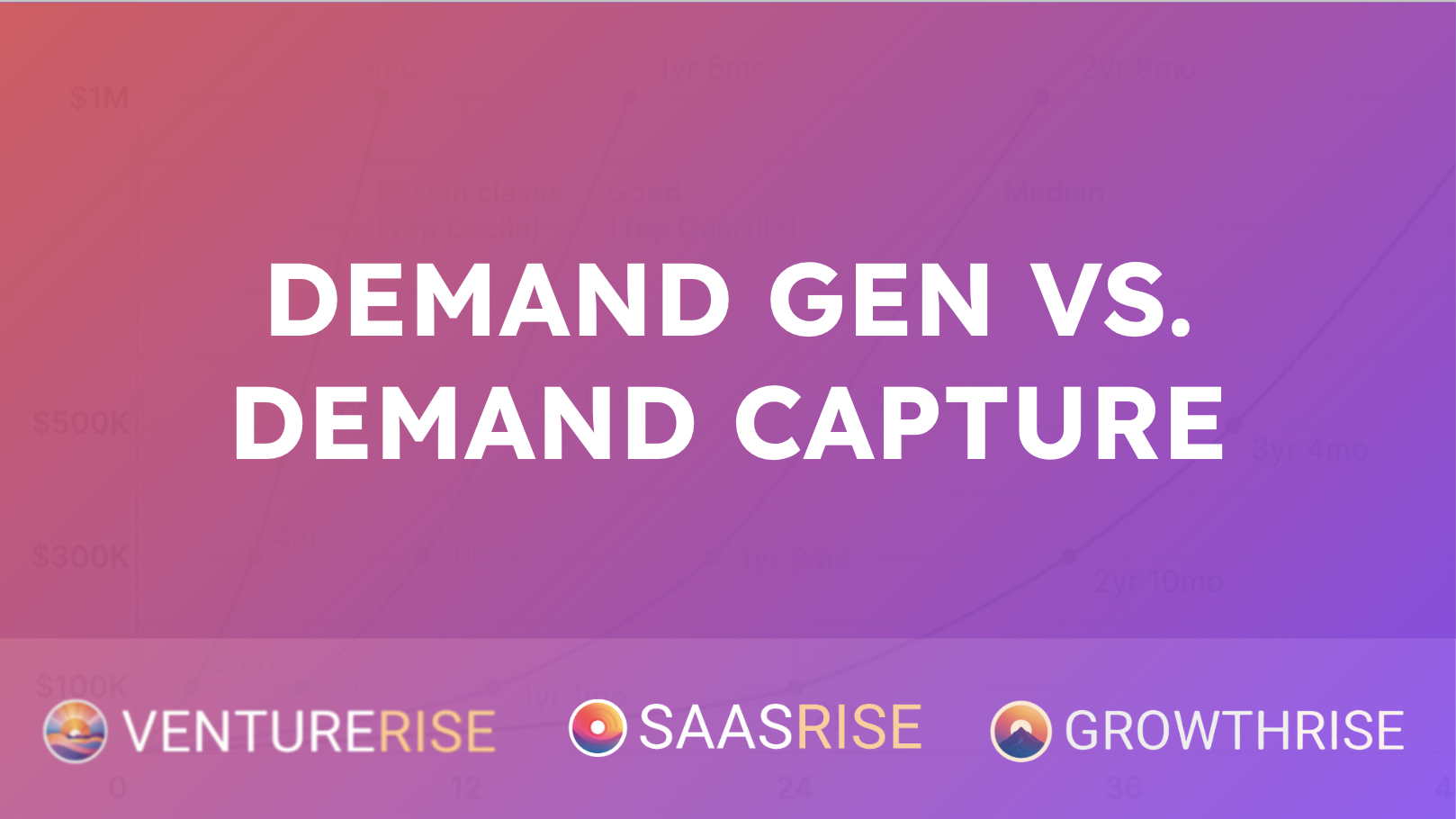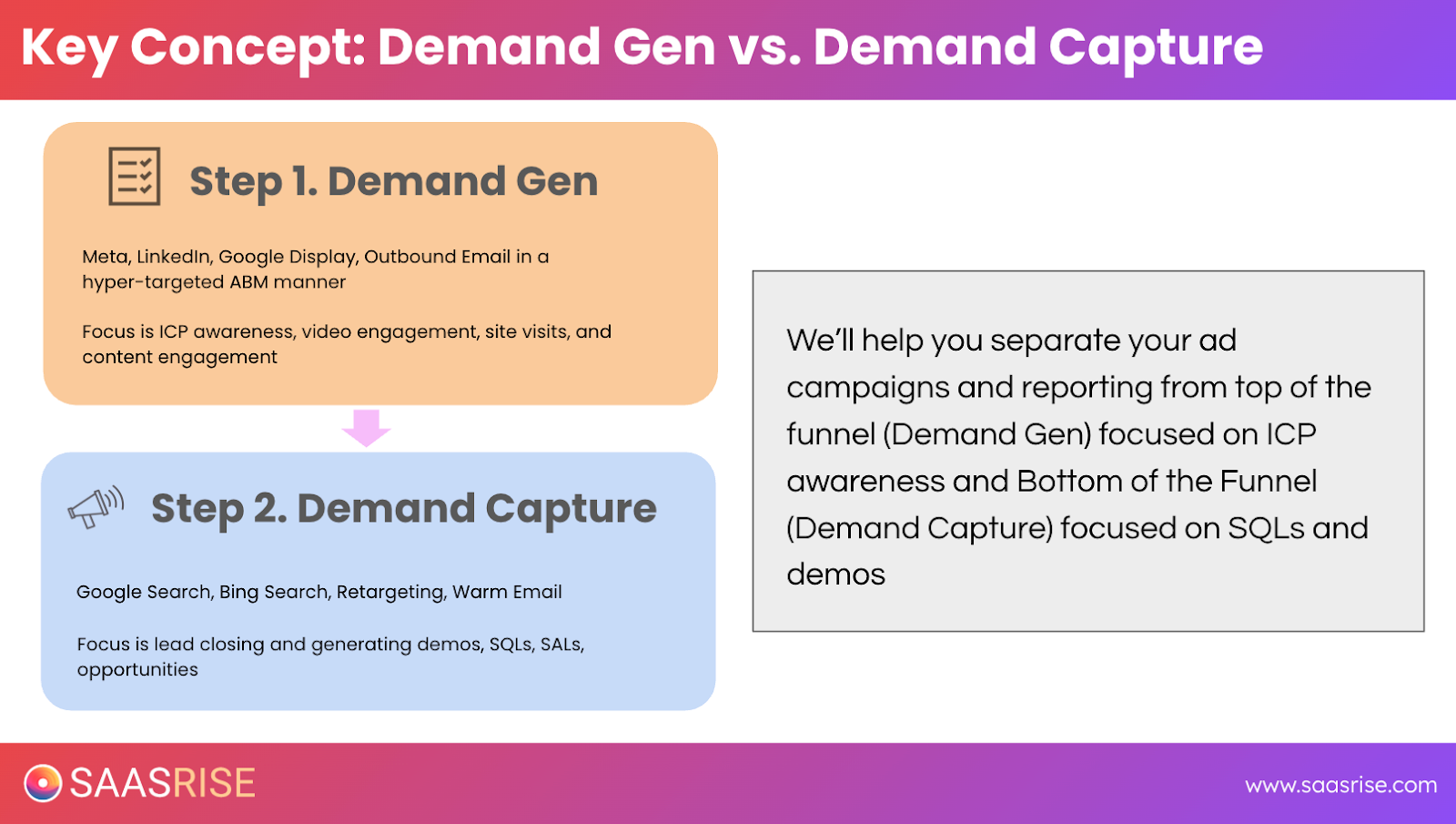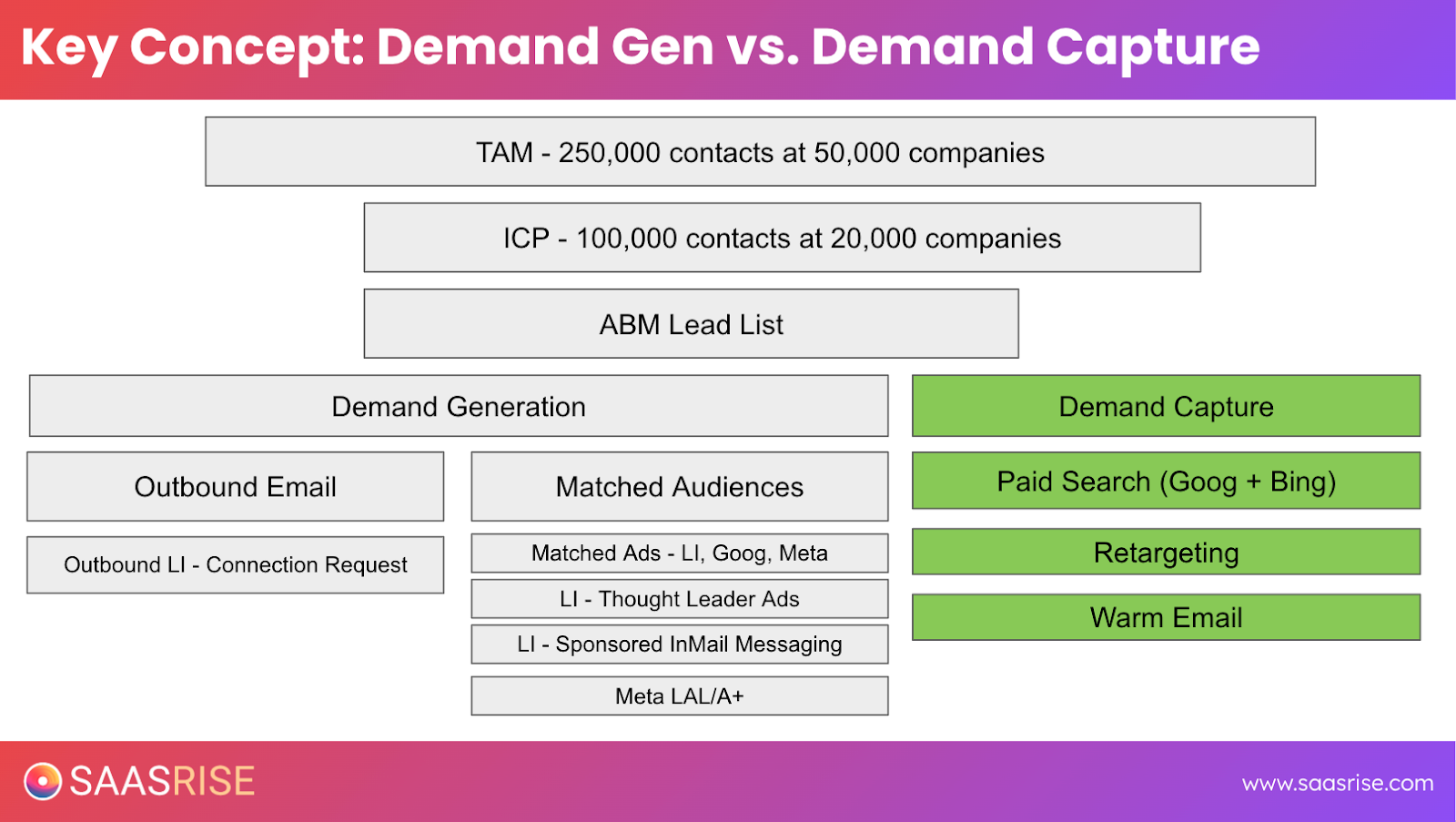
Demand Generation vs. Demand Capture
If you’ve been building or scaling a B2B SaaS company, you’ve probably heard the terms “demand generation” and “demand capture.” Most founders nod along when they hear those phrases — but if you press deeper, many can’t clearly explain how they differ or how to make them work together. And that’s where things start to break down.
In my early days building SaaS businesses, I thought a good funnel and decent sales process were enough. What I learned the hard way is that it’s not just about having a funnel that converts — it’s about filling that funnel with the right prospects, long before they’re even thinking about buying. That’s demand generation.
Then, when those prospects finally are ready to buy, you need to be right there waiting — with precision, timing, and relevance. That’s demand capture.
Get those two working in sync, and you’ve got a predictable growth engine. Ignore one, and you’ll plateau or start burning cash trying to scale.
Here’s what we’ll cover:
- What demand generation and demand capture really mean
- Why both are essential and how they work together
- A founder-tested framework to get both running
- The key metrics that actually matter
- Common mistakes I see SaaS teams make (and how to avoid them)
- My personal checklist for building a predictable growth engine
Let’s dive in.
1. What is Demand Generation and Demand Capture?

Demand Generation
Demand generation is the long game. It’s about creating awareness, interest, and trust before your ideal customer even starts Googling solutions like yours. You’re not chasing them when they’re ready to buy — you’re planting seeds long before that moment arrives.
Think of it like brand equity compounding over time. You’re lighting the signal in your market, helping your audience name their problems, and quietly building credibility so that six months later, when the timing is right, your name’s the one they remember.
In practice, this means:
- You’re targeting your ICP — often folks who don’t even know they have the problem you solve.
- You’re focused on awareness and consideration, not immediate conversion.
- You’re using tactics like thought leadership, podcasts, webinars, social content, outbound brand plays, and matched audience ads.
- Your ROI isn’t measured in weeks — it’s measured in quarters.
- Your metrics are softer: branded search growth, direct traffic, repeat visitors, social engagement, share of voice, video watch times, etc.
If it feels like you’re “playing the long game,” that’s because you are. Demand gen builds future pipeline. It’s the slow burn that eventually fuels scale.
Demand Capture
Demand capture is the sprint. It’s where you catch people who are already in-market — actively searching, comparing, and deciding.
These are the folks typing “best project management software” or “CRM alternatives to HubSpot” into Google. They’re already problem-aware and looking to buy.
This is where you show up and close.
Tactically, it looks like:
- Bidding on high-intent keywords in search
- Showing up on review sites like G2 and Capterra
- Running retargeting and competitor keyword campaigns
- Optimizing your landing pages and demo flows
- Having your SDRs follow up within minutes when someone requests a trial
It’s bottom-of-funnel stuff — short ROI cycles, measurable results, quick wins. You’re looking at metrics like cost per demo, cost per acquisition, pipeline created, conversion rate, and win rate.
Why the Distinction Matters
Here’s the trap: most SaaS companies over-index on demand capture because it’s easy to measure. You can see the conversions, you can tie the spend to pipeline, and it looks great on a dashboard.
But then — growth stalls. CAC climbs. Competitors outbid you. And you hit the ceiling of in-market buyers.
That’s when you realize: the number of people ready to buy right now doesn’t scale with your ad spend.
On the flip side, if you go all in on demand generation — podcasts, content, social reach — without a strong capture engine, you’re building awareness that leaks out the bottom. You’re lighting fires but not catching the heat.
The real magic happens when you run both — when you create demand and capture it with precision.
Winning SaaS companies don’t see these as two separate motions. They’re two legs of the same growth engine.

2. The Growth Engine: How Demand Generation and Capture Work Together
Here’s how I think about building this engine — the way I’ve done it across multiple SaaS businesses.
Step A: Build the Awareness and Trust Leg (Demand Gen)
Start by lighting up your ICP. These are the people who’d benefit from your product but aren’t actively looking.

Reach them through:
- LinkedIn and Meta matched audience ads
- Podcasts, webinars, and thought-leadership content
- Outbound ABM plays targeting ICP accounts
- Lookalike audiences and PR placements
This is about becoming familiar — the brand that keeps showing up in their world. Your goal is omnipresence. When they finally start researching, you’re already the default name in their mind.
Step B: Capture the Intent Leg (Demand Capture)
Once awareness starts building, you’ve got to be ready to catch the demand as it surfaces.
That means:
- Showing up for high-intent search queries (“best X software,” “alternatives to Y”)
- Getting featured — and bidding — on review sites
- Running retargeting ads to visitors who showed interest
- Offering smooth, conversion-optimized demo and trial flows
- Following up quickly with real humans, not bots
This is the part most SaaS companies are familiar with. But the ones that win at scale are the ones whose capture machine is fed by a strong generation engine.
Step C: Close the Loop
Once both legs are running, the real power comes from connecting them.
Demand gen fills the top of your funnel with warmed-up, problem-aware prospects. Demand capture catches them when they act.
Then, you feed insights from capture back into generation: which keywords convert, which audiences engage, which segments close faster. That feedback makes both stronger.
Over time, as your brand matures, your cost of capture drops — because branded search, referrals, and direct traffic rise.
How to Think About Budget
Here’s what I’ve seen work across dozens of SaaS businesses:
- If you’re early-stage, start with capture to prove ROI.
- Once you’ve got a repeatable sales motion, shift toward generation.
- A healthy mature split is around 60% demand gen / 40% demand capture — sometimes 50/50.
It’s not a hard rule — it’s a progression. As your brand grows, so does your long-term leverage.
3. The Framework: Building Your Dual Engine
Here’s the roadmap I’d follow if I were starting from scratch today.
Step 1: Define Your ICP and TAM
Before spending a dollar on ads or content, get clarity.
Who are your best-fit customers? What problem do you uniquely solve? How big is the market (your TAM)?
You can’t scale what you don’t define.
Step 2: Map the Buyer Journey
Most SaaS buyers go through four broad stages:
- Awareness – they’re just realizing they have a problem.
- Consideration – they’re exploring solutions.
- Evaluation – they’re comparing vendors.
- Decision & Onboarding – they’re ready to buy and implement.
Map what kind of content and experience they’ll need at each stage. You can’t talk to someone in “awareness” the same way you’d talk to someone in “evaluation.”
Step 3: Build the Demand Capture Foundation
Start here — get your capture system working.
- Run paid search campaigns targeting bottom-funnel keywords.
- Build strong landing pages with frictionless CTAs.
- Get on review sites and collect authentic reviews.
- Set up retargeting for everyone who visits your site or engages with your brand.
- Align with sales — your SDRs should follow up on demo requests fast.
Without this layer, your top-of-funnel demand gen won’t convert when people finally raise their hands.
Step 4: Launch Demand Generation Programs
Once capture is working, start building the demand gen muscle.
Create high-quality, founder-led content that speaks directly to your ICP’s pain points. Host webinars. Be a guest on podcasts. Run matched audience ads to your ICP list.
If you have a list of 100,000 contacts, that might turn into around 45,000 matched profiles on Meta, LinkedIn, and Google. Each network will have slightly different match rates, but that’s 45,000 people seeing your brand regularly — before they ever start searching. That’s how you plant seeds.
Outbound ABM works beautifully here too: pair personalized outreach with consistent brand impressions. It’s like showing up at a dinner party where everyone already knows your name.
Step 5: Connect, Measure, and Optimize
Now it’s all about tightening the feedback loops.
- Track which awareness content is driving later conversions.
- Use multi-touch attribution to understand how demand gen feeds capture.
- Add a “How did you hear about us?” field to every form — you’ll be shocked by what you learn.
- Run experiments constantly — test new content angles, ad creatives, and channels.
Demand capture scales linearly, but demand generation compounds. The longer you invest, the more momentum you build.
4. Key Metrics & Benchmarks
If you can’t measure it, you can’t improve it.
For Demand Capture:
- Cost per Lead (CPL)
- Cost per Demo or SQL
- CAC (Customer Acquisition Cost)
- Conversion Rate (click → demo → close)
- Time-to-Close
- ROAS (Return on Ad Spend)
- Win Rate
For Demand Generation:
- Branded Search Growth
- Direct Traffic Growth
- Engagement metrics (content downloads, podcast listens, webinar signups)
- Pipeline Influence (% of deals that interacted with top-of-funnel content)
- Lead Velocity Rate (LVR)
- Cost per Engagement
As a founder, you don’t need 100 metrics — just the vital ones that show if the machine’s working.
If your CAC is healthy and your time-to-close is steady, double down.
If your capture CAC starts rising fast, it’s a signal you’ve exhausted in-market demand. That’s when you push harder into demand gen.
5. Common Mistakes and How to Avoid Them
I’ve seen (and made) most of these over the years. Here are the big ones:
- Overinvesting in capture, ignoring generation.
You’ll get quick wins, but you’ll plateau. Capture buyers are finite. - Overinvesting in generation without a capture system.
You’ll build attention but won’t monetize it. - Using the same KPIs for both.
Demand gen is long-term; demand capture is short-term. Measure them differently. - Relying only on brand.
Vanity metrics don’t pay the bills. Track how awareness drives revenue. - No feedback loops.
Without attribution, you’ll spend blindly. - Poor sequencing.
Nail capture first. Then scale generation.
6. The Entrepreneur’s Checklist
When I work with founders at SaasRise, I often share this quick gut-check list:
- We’ve defined our ICP and TAM.
- Our capture engine (ads, review sites, landing pages) is converting profitably.
- We have full-funnel tracking and attribution in place.
- We’re producing regular thought-leadership content.
- We’re running matched audience ads and outbound campaigns.
- We track brand metrics (branded search, direct traffic).
- We’ve allocated budget across both engines and review quarterly.
- We experiment constantly.
- Marketing and sales are tightly aligned.
- We’ve built a feedback loop between the two motions.
- We’re adapting our approach as we scale — what worked at $1M ARR won’t work at $10M.
- We’re focused on both today’s buyers and tomorrow’s.
Final Thoughts
Scaling a SaaS business from $3M to $30M ARR isn’t about adding more SDRs or pouring more cash into ads. It’s about building a predictable, balanced engine that combines both demand generation and demand capture — working in harmony.
Demand capture gets you today’s revenue.
Demand generation builds tomorrow’s.
If you only capture, you’ll eventually stall.
If you only generate, you’ll struggle to convert.
But when you integrate the two, your growth becomes consistent, your CAC stays under control, and your brand starts doing the heavy lifting.
That’s how you build a B2B SaaS growth engine that scales predictably — not through hacks or luck, but through disciplined execution.
Here’s to building the next great SaaS success story.
— Ryan Allis, CEO, SaasRise

